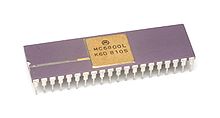Motorola 6800
The Motorola 6800 (MC6800) , not to be confused with the much more popular Motorola 68000 , is an 8-bit - processor of 1974 with 78 instructions and 1 or 2 MHz clock rate . It has a 16-bit address bus and can therefore address up to 64 KB of memory. It was one of the first microprocessors with an index register .
construction
Like the Intel i8080, the MC6800 is a typical representative of the first generation of microprocessors. Like this, he had a significant influence on further developments. While the architecture of the i8080 is based on the i8008 and thus the Datapoint 2200 processor, the PDP-11 is the decisive influence on the MC6800 . Design features of the MC6800 are:
- 8 bit data bus (bidirectional)
- 16 bit address bus
- 16 bit program counter
- 16 bit stack pointer
- 16 bit index register
- two 8-bit accumulators
- flexible address formation (direct, indexed)
- 5 V power supply
The "direct addressing", in which the first 256 bytes (addresses 00xx) could be addressed with shortened commands, contributed to the flexibility. While the 8080 had its own address space for input / output, this was mapped in the normal 16-bit address space on the MC6800. The 5 V power supply made it much easier to use than other processors (8080: three different voltages). This was achieved through an internal voltage doubler. The two-phase clock was generated externally (MC6875).
use
The MC6800 was only installed in a few home computers such as the SWTPC 6800 and the Altair 680 from MITS . In the first generation of electronic pinball machines from the manufacturers Bally and Williams , the 6800 can be found in all devices and was only replaced by the 6803 at Bally in 1985. It was also used in some commercial video games until the mid-1980s. The processor is built in LSI technology , has around 4,000 transistors and was normally delivered in a 40-pin DIP package. It is housing and signal compatible, but not software compatible with the MOS 6501 , which was replaced by the MOS 6502 following a patent infringement lawsuit in Motorola . This was built into the Apple II and many other home computers.
The MC6800 family
The MC6800 is the father of many processors, including the further developed M6809 , which could address indirectly indexed and was used in game consoles ( Vectrex ), in the Tandy TRS-80 Color Computer and Dragon 32 and in embedded applications. Other areas of application were the industrial area and special applications such as in the pharmacy computer area. The important operating system here was FLEX .
Further successors were the processors 6802/6808 and microcontrollers of the type 6801/6803 and 6805 in NMOS technology, 68HC05 , 68HC08 , 68HC11 , 68HC12 and 68HC16 in energy-saving CMOS technology. The types 6800 and 6802 were direct competitors of other 8-bit microprocessors of the first generation, such as Intel 8080 , MOS Technology 6502 or Zilog Z80 .

Peripheral chips
The MC6800 came with a number of peripheral chips that were also used with non-Motorola processors:
- MC6810 RAM - Static 128x8 RAM
- MC6820 - PIA - Peripheral Interface Adapter
- MC6821 - PIA - Peripheral Interface Adapter
- MC6822 - IIA - Industrial Interface Adapter, a PIA component for higher voltages
- MC6828 - PIC - Priority Interrupt Controller
- MC6829 - MMU - Memory Management Unit
- MC6830 ROM - Mask programmable 1024 × 8 ROM
- MC6835 - CRTC - Version of the 6845 with customer-specific programmed timing for two fixed formats
- MC6839 ROM function library with floating point functions
- MC6840 - PTM - Programmable Timer
- MC6843 - FDC - Floppy Disk Controller
- MC6844 - DMAC - Direct Memory Access Controller
- MC6845 - CRTC - picture address generator with programmable picture structure
- MC6846 - RIOT - ROM, I / O and timer in one chip
- MC6847 - VDG - Video Display Controller with integrated character set ROM for NTSC compatible output
- MC6850 - ACIA - Asynchronous serial interface
- MC6852 - SSDA - Synchronous Serial Interface
- MC6854 - ADLC - Advanced Data Link Controller, complex serial interface
- MC6859 - DSD - block encryption and decryption according to DES
- MC6883 - SAM - Synchronous Address Multiplexer for DRAM control (SN74LS783)
Individual evidence
- ↑ Motorola Semiconductors: 8-Bit Microprocessors Data Manual . Switzerland 1983.
Literature and web links
- M6800 Microprocessor Application Manual. (PDF; 30 MB) Motorola , 1975, accessed on October 16, 2017 (English).
- M6800 Programming Reference Manual. (PDF; 6.6 MB) Motorola , October 1976, accessed on October 16, 2017 (English).

